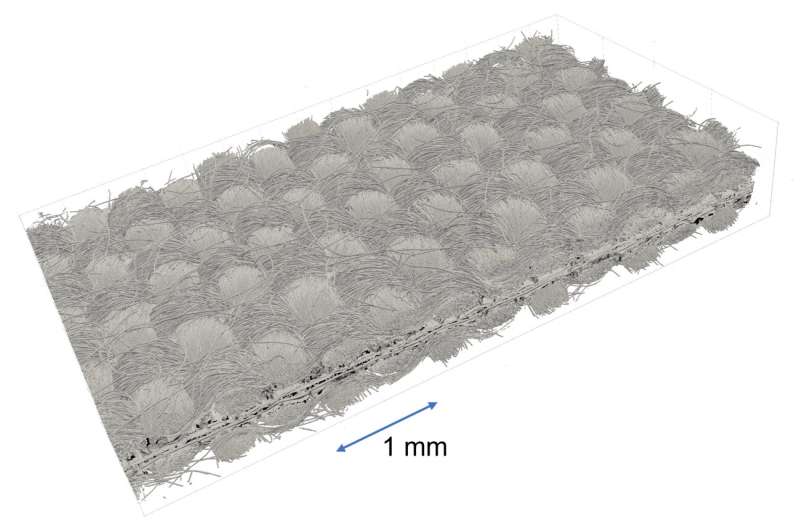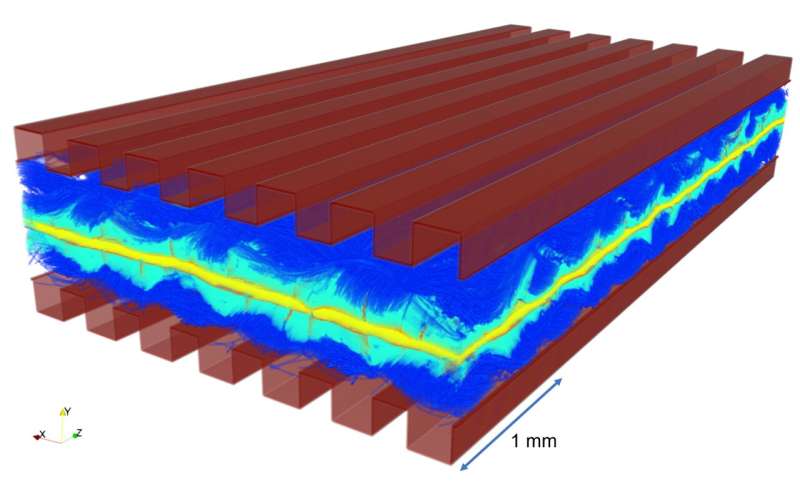February 21, 2023 dialog
This article has been reviewed according to Science X's editorial process and policies. Editors have highlighted the following attributes while ensuring the content's credibility:
fact-checked
peer-reviewed publication
trusted source
written by researcher(s)
proofread
We developed an algorithm to massively improve hydrogen fuel cell imaging and water modeling

We developed an algorithm to massively improve images of hydrogen fuel cells, with future applications in medical scanning.
This project started when one of our collaborators (Dr. Robin T. White) from Zeiss, the leading microscopy manufacturer, had some interesting images at different resolutions of a fuel cell, and we had spoken of super-resolution before with Prof Ryan Armstrong. The project quickly grew to a large team (13 researchers over three continents, four research institutes and two companies), with expertise in different areas from electrochemistry and fuel cell engineering to X-ray imaging, deep learning, and fluid flow mechanics. The right people were available at the right time!
We have developed an algorithm to produce high-resolution modeled images from low-resolution micro-X-ray computed tomography (CT). This exciting new tool, published in a paper in Nature Communications, was evaluated on hydrogen fuel cells to model their structure with higher details and potentially improve their efficiency.
Hydrogen fuel cells use hydrogen fuel to generate electricity and are a quiet, and clean energy source that can power homes, vehicles, and industries. Fuel cells convert hydrogen, via an electrochemical process, into electricity with the only by-product of the reaction being pure water. However, hydrogen fuel cells become inefficient if the water is not removed fast enough and floods the system. Our team developed the algorithm to understand how this flooding happens inside a fuel cell
Boosting resolution
Our solution uses deep learning to create a detailed 3D model by utilizing a low-resolution X-ray image of the entire cell and extrapolating data from an accompanying high-res scan of a small sub-section. As an analogy, we have taken a blurry aerial view of a town, and an optically zoomed-in photo of a few streets, and then accurately predicted the layout of every road in the area! In the case of 3D CT images of fuel cells as per this study, our custom neural network is designed to efficiently generate terabyte-scale models on desktop computers. This is particularly exciting because we are pushing the imaging resolution limits by a few orders of magnitude using machine learning and AI!
Our algorithm improves the field of view around one hundred times compared to the high-res image. If you were to look at what we are doing now and apply it to the medical field, we could for instance image blood vessels and model the flow of red blood cells through the capillary network in greater detail.
These beyond-hardware imaging and modeling methods extend beyond fuel cell imaging to enable higher-resolution imaging of larger fields of view than anything previously possible. Currently, the large-scale low-res image and the small-scale high-res image need to be taken on the same sample and on the same machine. However, future research should soon allow deep learning techniques to produce comparable results without matching areas or even instruments.

Fast-fueling PEMFCs
During training and testing, the algorithm was 97.3% accurate to produce a high-res model from low-res images. It also produced the high-res model in 1 hour, compared to the whopping 1,188 hours necessary to scan the whole section of the fuel cell with that resolution using an actual micro-CT scanner. From our model, we quickly and precisely identify where water accumulates, and we potentially solve those problems in future designs.
There is a huge untapped performance improvement that could be made using these cells, just by improved water management, and that is estimated to be a 60 percent increase overall. For the past 20 years, up until now, it has been extremely hard to have an accurate model of these fuel cells because of the complexity of both the materials and the way gases and liquids are transported, as well as the electrochemical reactions taking place. Our team has enabled us to do just that, bringing so much different expertise to the table. This is what research is about.
This story is part of Science X Dialog, where researchers can report findings from their published research articles. Visit this page for information about ScienceX Dialog and how to participate.
More information: Ying Da Wang et al, Large-scale physically accurate modelling of real proton exchange membrane fuel cell with deep learning, Nature Communications (2023). DOI: 10.1038/s41467-023-35973-8
Bios:
Dr Quentin Meyer defended his PhD in Advanced Diagnosis for Proton Exchange Membrane Fuel Cells in 2015 with an Award for Research Excellence (University College London, London UK). After a post-doctoral position in 3-D imaging of hydrogen fuel cells at University College London, he relocated to Australia in 2017 and joined Prof Zhao's group as a senior researcher and laboratory manager (>20 people) at the University of New South Wales (Sydney, Australia) in 2018. His research topics deal with the electrocatalysis of complex reactions, focusing on the structure-to-performance relationships, and investigating the activity and durability of low-cost electrocatalysts for fuel cell and electrolyzer applications. As of February 2023, he has published 52 journal articles, filed a patent, and given over twenty-five communications at national and international conferences and ten invited seminars.
Dr Ying Da Wang obtained his PhD in Machine Learning and Efficient Computational Methods for Digital Porous Media in 2020 at the University of New South Wales, Australia, and is currently a post-doctoral researcher at the same institution. He supervises and manages the computational modeling side of the MUTRIS (Multiscale Transport in Porous Systems) research group under Prof. Ryan Armstrong and Prof. Peyman Mostaghimi. His research focuses on (a) Machine Learning Methods for Digital Porous Media, and (b) Efficient and Massive Computations of Pore Scale Flow, which has garnered him expertise in Super Resolution and Image Enhancement, Multi-Label Segmentation, and High Performance Flow Simulation. As of February 2023, he has published 27 journal articles, and presented his findings at multiple technical conferences.
Science X















